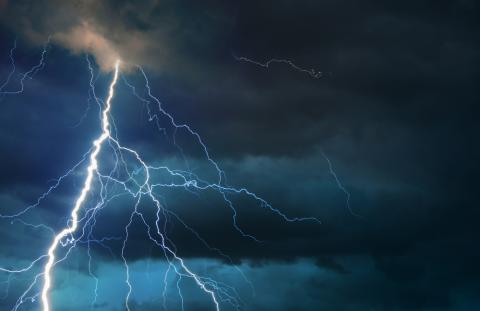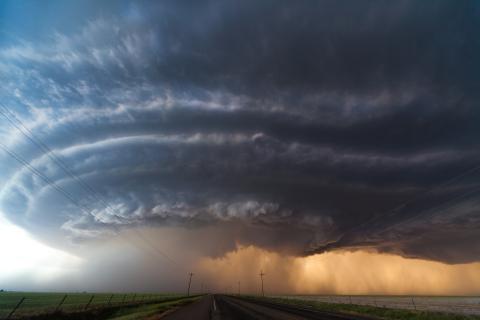Climate and Health: Severe Storm Safety
While not in an especially tornado-heavy part of the United States, Wisconsin still experiences, on average, 23 tornadoes per year. The high winds and severe storms that can accompany tornadoes pose serious health hazards to the people of Wisconsin.
Severe storm toolkit
Wisconsin Thunderstorm and Tornado Toolkit, P-01037 (PDF) - This toolkit provides general information and guidance for severe thunderstorms and tornadoes including general information, talking points, and message maps for local public health partners.
Stay alert for severe weather
Severe storms can come with little warning. Heed storm watches in your area and listen to radio stations or news channels for up to date information.
Develop a home emergency plan
Develop a plan. Find areas in your home where you and your family can take shelter with no windows to the outside and be sure to practice with your family.
Check on your neighbors after the storm
Isolated or elderly individuals can be unaware of rapidly changing weather conditions and may be more vulnerable to injury during severe weather.
Tornado information
Tornado
A violently rotating column of air that extends from a thunderstorm to the ground and is often—although not always—visible as a funnel cloud. Lighting and hail are common in thunderstorms that produce tornadoes.
Tornado watch
An alert issued when weather conditions favor the formation of tornadoes—often during thunderstorms.
Tornado warning
An alert issued when a funnel cloud is sighted or indicated by weather radar. Shelter should be taken immediately.
Funnel cloud
A visible, rotating, funnel-shaped cloud that extends from a thunderstorm toward but not quite reaching the ground
Listen to radio, television, or weather alert radios for National Weather Service bulletins. Weather Alert Radios receive broadcasts and alerts from the local National Weather Service station and are available at most electronics dealers.
When a tornado threatens, taking immediate action can save your life! Stay away from windows, doors, and outside walls, protect your head.
Most tornado damage is caused by violent winds, and many injuries and deaths result from flying debris.
- In homes and small buildings, go to the basement or to an interior part on the lowest level such as closets, bathrooms or interior halls. Get under something sturdy. Do not leave the building until the storm has passed.
- In schools, nursing homes, hospitals, factories, and shopping centers, go to pre-designated shelter areas. Interior hallways on the lowest floor are usually best. Avoid auditoriums, gymnasiums, or other structures with wide, free-span roofs.
- In high-rise buildings, go to interior small rooms or hallways.
- In vehicles or mobile homes, leave them and go to a substantial structure. If there is no shelter nearby, lie flat in the nearest ditch, ravine, or culvert with your hands shielding your head.
- In open country, lie flat in the nearest ditch or ravine with your hands shielding your head.
- Note: Take a portable radio and flashlight with you when taking shelter.
Season: Wisconsin's tornado season generally runs from April through September, though the earliest recorded tornado hit Evansville in February 2024 during a time of record high temperatures. The greatest numbers of tornadoes have occurred in May, June, and July. Wisconsin averages more than 20 tornadoes per year, although in 2005, there were more than 60 tornadoes in our state.
Time of day: The majority of tornadoes have struck during mid-afternoon or early evening (3 p.m. to 7 p.m.). However, tornadoes may strike at any time, potentially with little or no warning. The devastating Barneveld / Black Earth twister occurred around 1 a.m. without warning.
Movement: Tornadoes usually move from the southwest to the northeast; however, direction of travel may be erratic and change suddenly.
Thunderstorm information
Severe thunderstorm watch
Weather conditions suggest that severe thunderstorms are possible in the area.
Severe thunderstorm warning
Severe thunderstorms are occurring in the area.
Heat lightning
Lightning from a thunderstorm too far away to be heard
Straight line winds
Any wind generated by a thunderstorm that is not associated with rotation and can be considered severe if the winds exceed 58 mph. Damage from straight-line winds occurs in the same general direction due to lack of rotational wind
Wall cloud
An isolated, often abrupt, lowering of a cloud that develops beneath the base of a thunderstorm. It is always rain-free and usually exists for 10-20 minutes before a tornado appears. A wall cloud may also persistently rotate.
Follow these safety tips during thunderstorms:
- Keep calm. Thunderstorms are usually brief; even squall lines pass in a few hours. Stay indoors.
- Consult radio, television, weather alert radios for National Weather Service bulletins.
- When a thunderstorm threatens, go inside a home or large building, or inside an all-metal (not convertible) vehicle.
- Avoid using the telephone, except for emergencies.
If outside, with no time to reach a safe building or vehicle, follow these rules:
- Do not stand underneath a natural lightning rod such as a tall, isolated tree in an open area.
- Avoid projecting above the surrounding landscape, such as standing on a hilltop, in an open field, on the beach, or fishing from a small boat.
- Get out of and away from open water.
- Get away from tractors and other metal farm equipment.
- Get off of and away from motorcycles, scooters, golf carts and bicycles. Put down golf clubs.
- Stay away from wire fences, clotheslines, metal pipes, rails and other metallic objects that could carry lightning to you from some distance away.
- Avoid standing in small, isolated sheds or other small structures in open areas.
- In a forest, seek shelter in a low area under a thick growth of small trees.
- In open areas, go to a low place such as a ravine or valley. Be alert for flash floods.
If you're hopelessly isolated in a level field or prairie and you feel your hair stand on end indicating lightning is about to strike, squat low to the ground, on the balls of your feet. Place your hands on your knees with your head between them. Make yourself the smallest target possible and minimize your contact with the ground. Do not lie flat on the ground.
Adapted from National Weather Service, Wisconsin Emergency Management, and Federal Emergency Management Agency publications.
Injury can result directly from the tornado or severe storm, and can also occur after the tornado when people are walking among damaged or destroyed buildings. Tornadoes often damage power lines, gas lines, or electrical systems. Because of this, there is an increased risk of fire, electrocution, or explosion.
- Continue to monitor your battery-powered radio or television for emergency information.
- Only enter severely damaged buildings after they have been inspected for structural integrity.
- Be careful when entering any structure that has been damaged.
- Wear sturdy shoes or boots, long sleeves, and gloves when handling or walking on or near debris.
- Safely work in teams if possible during cleanup efforts.
- Be aware of hazards from exposed nails and broken glass.
- Do not touch downed power lines or objects in contact with downed lines. Report electrical hazards to the police and the utility company.
- Use battery-powered lanterns, if possible, rather than candles to light homes without electrical power. If you use candles, make sure they are in safe holders away from curtains, paper, wood, or other flammable items. Never leave a candle burning when you are out of the room.
- Never use generators, pressure washers, grills, camp stoves, or other gasoline, propane, natural gas, or charcoal-burning devices inside your home, garage, or camper—or even outside near an open window, door, or vent as these generate carbon monoxide (CO). CO is an odorless, colorless gas that can cause sudden illness and death if you breathe in high concentrations of it. CO from these sources can build up in your home, garage, or camper and poison the people and animals inside. Seek prompt medical attention if you suspect CO poisoning and are feeling dizzy, light-headed, or nauseated.
- Hang up displaced telephone receivers that may have been knocked off by a tornado, but stay off the telephone, except to report an emergency.
- Cooperate fully with public safety officials.
- Respond to requests for volunteer assistance by police, firefighters, emergency management, and relief organizations, and do not go into damaged areas. Your presence could hamper relief efforts, and you could endanger yourself.
- Be aware of damaged areas that may have controlled access.
For more information, email us at DHSClimate@dhs.wisconsin.gov or call us at 608-266-1120.


